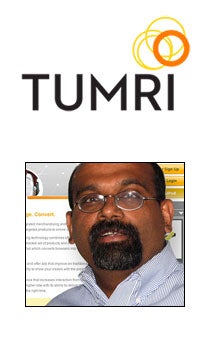 Hari Menon is CEO of Tumri, Inc., a dynamic marketing solutions company for display media.
Hari Menon is CEO of Tumri, Inc., a dynamic marketing solutions company for display media.
AdExchanger.com: What has happened with Tumri in the past year?
Tumri has undergone a major shift in strategy and management in the last year. Tumri has always had a powerful technology platform that has allowed us to deliver on a broad range of capabilities in the dynamic creative space. Our technology platform has been leveraged by more than 300 Dynamic Ad Campaigns – more than any other vendor in the space.
For the past year, we have been focused on two key areas: 1) making dynamic creative easy by building agency and partner self-serve capabilities that allows them to develop, manage, and analyze their campaigns directly, and 2) building high-value solutions based on our platform that speak to specific business needs.
How are you positioning Tumri today? Is it still a dynamic creative solution?
We still view ourselves as the leaders in the dynamic creative space. We view our role in that space as delivering audience relevant advertising across the purchase funnel. To bring clarity to the space, we are leveraging our technology platform to deliver solutions in the following areas:
- Testing and Research – Creative testing and research that provide insights into broad engagement and efficacy differences among various creative elements, attributes and variations across media and audiences.
- Creative Optimization – Delivering measurable improvements in advertising performance based on optimization of creative components across audiences, placements, geography, and technographic attributes
- Retargeting – providing significant performance improvements in direct marketing campaigns, based on revealed consumer purchase intent, particularly in the Travel , Retail and Consumer Electronics verticals
- Personalization and Localization – providing the ability to efficiently deliver national or regional campaigns with Geo and/or Audience targeted messaging and creative variations
Who do you see as the target market? Is it creative agencies, media agencies – do you partner…? DR, brand marketers?
Our focus is on the players in the digital ad space who set the direction for digital campaigns. As a result, we are selling targeted solutions to different players based on their specific needs. For example, our research offerings speak directly to the needs of brand marketers who want to understand the efficacy of different creative concepts, elements and messages across media and audiences. Our Optimization, Personalization and Retargeting offerings provide powerful results for branded performance marketers looking for performance without sacrificing brand safety and transparency.
Creatives and their teams sometimes pushback on the use of technology in their idea creation process. Do you see this? How will you overcome the challenge, if so?
Creative people love to be creative. They will embrace tools that help them to create better ads. We view our tools a providing a whole new dimension to the creative palette. We extend the tools they use today to allow a whole new dimension – creative variation. The feedback we’ve gotten from the users of our design product (Tumri Dynamic Design) has been very positive. Designers and developers love the flexibility it gives them and the ease of use.
What pricing models will you offer?
Historically, we’ve priced our products somewhat like Ad server solutions and Rich Media offerings, on a CPM basis. This has fit well in the ad ecosystem. Going forward, we’re looking at different options including subscription pricing to drive faster, broader adoption of our offerings.
Is service an important component of what Tumri offers today? What’s your view on the importance of service to your product?
Service will always be important in the ad industry. The business of developing, managing, and analyzing dynamic campaigns has been hard, requiring lots of heavy lifting on our part, on the parts of our advertising partners, and the parts of our publisher partners. That’s why we’ve invested so much in building tools that make it all easier.
Our Tumri Dynamic Design tool makes the design of dynamic ads a simple extension of the Flash development process. Our Tumri Campaigner makes it easy for an agency or advertiser to set up the dynamic campaign, manage the dynamic variables, and traffic the campaign without all the pain that has characterized this industry for years. Finally, our Tumri Dynamic Insights analytics portal makes it easy for an advertiser to see how their campaigns are performing and identify changes that can drive performance even higher.
We will continue to focus on giving our clients what they need to capture on the value potential of our offerings. Going forward, we believe that value will come much more from our clients using our software and less from Tumri providing direct services to those clients. Either way, what is important is that the advertiser sees the value of our solutions and achieves their objectives.
What formats and platforms do you address today and how will that evolve in the year ahead?
At our core, we are platform agnostic. Our decision framework can work across any platform. That said, we have worked mostly in the display space, including some in-banner video. As other platforms develop more-sophisticated requirements, we will extend our platform to address those areas. The good news is that that kind of extension is much more incremental for us, not fundamental.
How many employees is the company today? Do you anticipate seeking another round of funding?
We have 50 employees in the company with operations in US and India. Tumri is adequately funded to get to a cash flow positive status. If we take another round of funding, it will be to help us grow our business in multiple dimensions – other channels and markets.
Overall, what has surprised you about online advertising in the past year?
For us, what has been most surprising is that the eco-system has paid very little attention to the last mile – i.e. the creative. Most of the attention and investment in the space has gone towards buying media and reaching the target audience efficiently. We are very happy with the developments in the last year. Our hope is that the emergence of exchanges, DSPs and agency trading desks will provide a method to the madness of media buying. The next frontier to generate better performance from display advertising has to be “the creative”. We are now starting to see the market come to us – i.e. more RFPs with creative optimization and personalization, CMOs talking about audience-targeted messaging etc.
A year from now, what milestones would you like the company to have accomplished?
One year from now, we want leading digital advertisers to have trouble imagining how they ever got by without dynamic components in all of their campaigns. We are totally focused on enabling our clients to achieve unprecedented relevance in advertising by making dynamic personalized creatives easy and ubiquitous. We want our clients to get the value of Dynamic Creative without the challenges that have characterized the space in the past.
Follow Tumri (@Tumri) and AdExchanger.com (@adexchanger) on Twitter.













